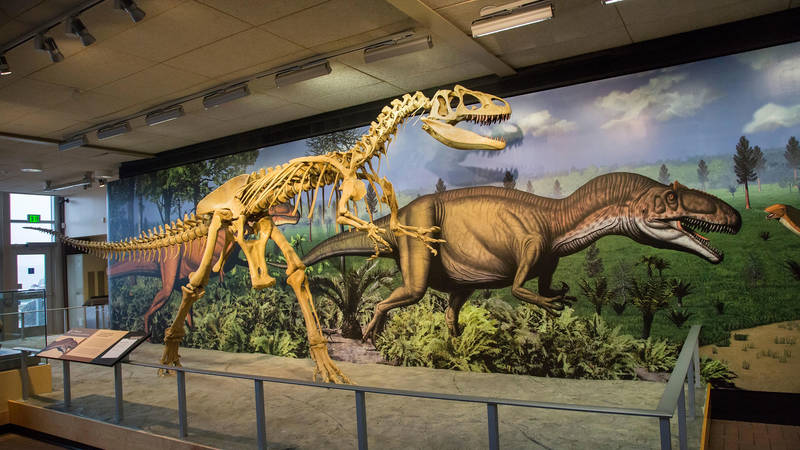The discovery of yet another shark species continues the archaeological breakthroughs at Mammoth Cave National Park, which has a pretty fascinating human history, too.
A seafloor covered much of central Kentucky 340 million years ago, with a variety of aquatic creatures swimming in its depths. Among them were at least 40 different species of sharks and their relatives. Several of those species are new to science, including one announced in March by the National Park Service.
Researchers identified Clavusodens mcginnisi— or “McGinnis’ nail tooth” — through fossil teeth collected from deep inside the Ste. Genevieve Formation, one of four major rock formations within Mammoth Cave National Park. This layer of limestone and shale formed on the bottom of a warm ocean reef.
Prior to research that began at the park in 2019, no shark fossils were known to be in the Ste. Genevieve Formation. To date, over 70 species of sharks and other fish have been identified from the Ste. Genevieve Formation, including four new species.
The shark measured just 3 to 4 inches long. The species’ small size allowed it to avoid larger predators as it foraged on crustaceans, worms and small brachiopods found along the sea floor, according to a Park Service news release. The name “nail tooth” derives from the shark’s back teeth, which resembled old iron nails because of their flat crowns and long bases.
Researchers named the news species for retired Park Service superintendent and naturalist David McGinnis, who started his 39-year career at Mammoth Cave.
Clavusodens mcginnisi isn’t the only recent shark discovery — or the only one named for park staff.
The first shark species discovered inside the Ste. Genevieve Formation was Strigilodus tollesonae, which translates to “Tolleson’s scraper tooth,” which the Park Service announced in October 2023. Researchers believe the species may have lived like a modern skate. They named it after park guide Kelli Tolleson, who provided field support for paleontological research at Mammoth Cave.

Where to Touch a Dinosaur, and Other Incredible National Park Fossil Sites
Cool creatures from the past and where to see them
See more ›In February 2024, the park announced the discovery of two additional shark species, Troglocladodus trimblei and Glikmanius careforum, which were identified by fossils in the Ste. Genevieve Formation, as well as St. Louis Limestone, another rock formation at the park. Both species are estimated to have reached 10-12 feet in length. The first was named in honor of Mammoth’s Park Superintendent Barclay Trimble, who found the first specimen, a single tooth, in 2019. The second species honors the Cave Research Foundation, which supports research at Mammoth Cave.
The park’s fossil treasures showcase one of the most diverse shark faunas of the Mississippian period in North America, according to the Park Service. Understanding these ancient sharks and their anatomy helps scientists to better understand the relationship and evolution of modern shark species.
Why is the park called ‘Mammoth’?
Designated a UNESCO World Heritage Site and an International Biosphere Reserve, Mammoth Cave National Park encompasses 52,830 acres of wilderness and contains the longest cave system in the world. Over 400 miles of caves have been mapped, and the end has yet to be found. It earned the name Mammoth because of the size of the system as well as the grandeur of its chambers.
The large underground system formed as water slowly dissolved carbonate rocks and created sinkholes, tunnels and rivers — a terrain known as karst. This particular site is part of a limestone belt extending from southern Indiana through Kentucky into Tennessee. The rocks that form the park were produced from sediments deposited when this area was submerged by an ancient ocean.
According to the Park Service’s timeline, the prehistoric seas deposited layers of limestone at about 325 million BCE, and rainwater began dissolving that rock to form Mammoth Cave’s passages at about 10 million BCE.
Curious human imprints
Evidence suggests prehistoric people began using the cave for shelter and minerals collection about 5,000 to 2,000 BCE. In the 1790s, settlers began mining the caves for saltpeter, a main ingredient used in producing gunpowder — an enterprise that within a few years had enslaved people doing most of the work.
Mammoth’s Master Explorer
After the War of 1812, the demand for saltpeter diminished and the caves became a world-renowned tourist destination, with three stage-coach lines bringing visitors from nearby towns. They also arrived by steamboat up the Green River or by train.
For more than a century, Black people led many of the guided tours of the caves — even after gaining their freedom at the end of the Civil war. Women also led tours.
Among the park’s stories, photojournalist Frances Benjamin Johnston became the first woman to publish a series of photos from inside Mammoth Cave in the late 1800s while on assignment for Demorest’s Family Magazine. To achieve her dramatically lit images, she mixed magnesium and chlorate of potash powders and lit them on the spot for “flash light.”
In 1938, researchers from the University of Chicago conducted a groundbreaking sleep study in the cave, looking at the fluctuations of wakefulness and body temperature and how the absence of natural light influences mental performance and biological rhythms.
One African American family, the Bransfords, had a legacy of multigenerational cave guides until the area was designated a national park in 1941. In 2004 Jerry Bransford, the great-great-grandson of an original enslaved guide, continued the family tradition when he began work as a guide for the National Park Service.
Want to visit?
Mammoth Cave National Park is about 35 minutes northeast of Bowling Green, Kentucky, and about two hours southwest of Lexington, Kentucky. The park does not charge an entrance fee.
Stay On Top of News
Our email newsletter shares the latest on parks.
Tickets are required for cave tours, which are offered at various lengths and levels of difficulty. The park strongly recommends reserving cave tour tickets in advance, as tours often sell out during the summer and early fall seasons. Visit the park’s website for driving directions, frequently asked questions and more.
About the author
-
 Linda Coutant Staff Writer
Linda Coutant Staff WriterAs staff writer on the Communications team, Linda Coutant manages the Park Advocate blog and coordinates the monthly Park Notes e-newsletter distributed to NPCA’s members and supporters.